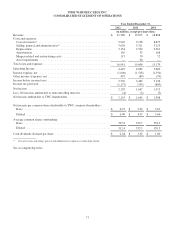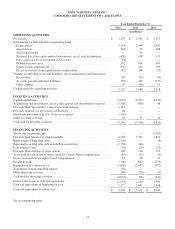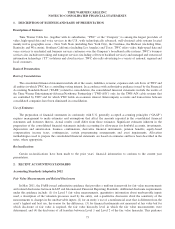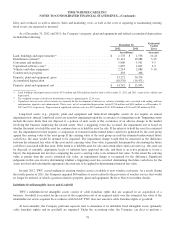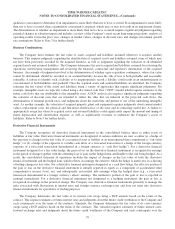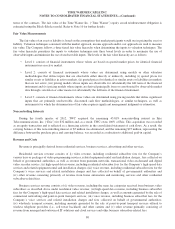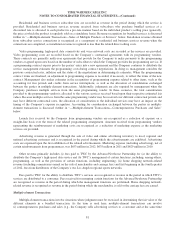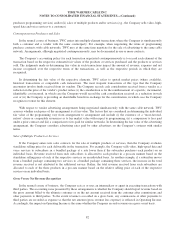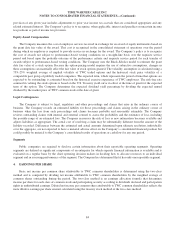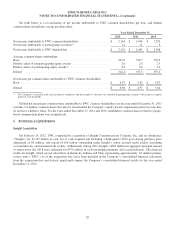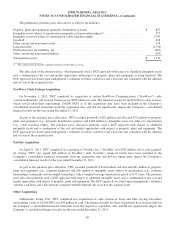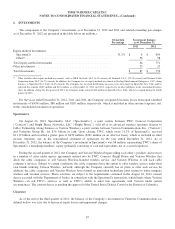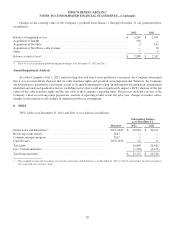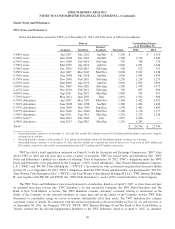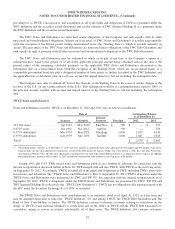Time Warner Cable 2012 Annual Report Download - page 91
Download and view the complete annual report
Please find page 91 of the 2012 Time Warner Cable annual report below. You can navigate through the pages in the report by either clicking on the pages listed below, or by using the keyword search tool below to find specific information within the annual report.TIME WARNER CABLE INC.
NOTES TO CONSOLIDATED FINANCIAL STATEMENTS—(Continued)
Residential and business services subscriber fees are recorded as revenue in the period during which the service is
provided. Residential and business services revenue received from subscribers who purchase bundled services at a
discounted rate is allocated to each product in a pro-rata manner based on the individual product’s selling price (generally,
the price at which the product is regularly sold on a standalone basis). Revenue recognition for bundled services is discussed
further in “—Multiple-element Transactions—Sales of Multiple Products or Services” below. Installation revenue obtained
from subscriber service connections is recognized as a component of residential and business services revenue when the
connections are completed, as installation revenue recognized is less than the related direct selling costs.
Video programming, high-speed data connectivity and voice network costs are recorded as the services are provided.
Video programming costs are recorded based on the Company’s contractual agreements with its programming vendors.
These contracts are generally multi-year agreements that provide for the Company to make payments to the programming
vendors at agreed upon rates based on the number of subscribers to which the Company provides the programming service. If
a programming contract expires prior to the parties’ entry into a new agreement and the Company continues to distribute the
service, management estimates the programming costs during contract negotiations. In doing so, management considers the
previous contractual rates, inflation and the status of the negotiations in determining its estimates. When the programming
contract terms are finalized, an adjustment to programming expense is recorded, if necessary, to reflect the terms of the new
contract. Management also makes estimates in the recognition of programming expense related to other items, such as the
accounting for free periods and credits from service interruptions, as well as the allocation of consideration exchanged
between the parties in multiple-element transactions. Additionally, judgments are also required by management when the
Company purchases multiple services from the same programming vendor. In these scenarios, the total consideration
provided to the programming vendor is allocated to the various services received based upon their respective estimated fair
values. Because multiple services from the same programming vendor may be received over different contractual periods and
may have different contractual rates, the allocation of consideration to the individual services may have an impact on the
timing of the Company’s expense recognition. Accounting for consideration exchanged between the parties in multiple-
element transactions is discussed further in “—Multiple-element Transactions—Contemporaneous Purchases and Sales”
below.
Launch fees received by the Company from programming vendors are recognized as a reduction of expense on a
straight-line basis over the term of the related programming arrangement. Amounts received from programming vendors
representing the reimbursement of marketing costs are recognized as a reduction of marketing expense as the marketing
services are provided.
Advertising revenue is generated through the sale of video and online advertising inventory to local, regional and
national advertising customers and is recognized in the period during which the advertisements are exhibited. Advertising
costs are expensed upon the first exhibition of the related advertisements. Marketing expense (including advertising), net of
certain reimbursements from programmers, was $653 million in 2012, $635 million in 2011 and $629 million in 2010.
Other revenue primarily includes (i) fees paid to TWC by the Advance/Newhouse Partnership for (a) the ability to
distribute the Company’s high-speed data service and (b) TWC’s management of certain functions, including, among others,
programming, as well as the provision of certain functions, including engineering; (ii) home shopping network-related
revenue (including commissions earned on the sale of merchandise and carriage fees) and (iii) beginning in the fourth quarter
of 2012, fees from distributors of the Company’s two Los Angeles regional sports networks.
Fees paid to TWC for the ability to distribute TWC’s services are recognized as revenue in the period in which TWC’s
services are distributed to a consumer. Fees received for managing certain functions for the Advance/Newhouse Partnership
are recognized as revenue in the period during which the management functions are performed. Home shopping network-
related revenue is recognized as revenue in the period during which the merchandise is sold or the carriage fees are earned.
Multiple-element Transactions
Multiple-element transactions involve situations where judgment must be exercised in determining the fair value of the
different elements in a bundled transaction. As the term is used here, multiple-element transactions can involve
(i) contemporaneous purchases and sales (e.g., the Company sells advertising services to a customer and at the same time
81


